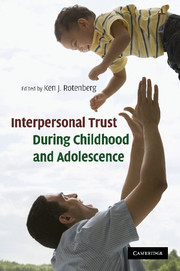Book contents
- Frontmatter
- Contents
- List of figures
- List of tables
- List of contributors
- Section I Conceptual foundations and issues
- Section II Childhood
- Section III Adolescence and early adulthood
- 10 Trust, but verify: Knowledge, disclosure, and mothers' beliefs about adolescents' trustworthiness
- 11 The role of trust in adolescent–parent relationships: To trust you is to tell you
- 12 A new scale for the assessment of adolescents' trust beliefs
- 13 A friend in need is a friend indeed: Exploring the relations among trust beliefs, prosocial tendencies, and friendships
- 14 Promoting intergroup trust among adolescents and young adults
- Index
- References
10 - Trust, but verify: Knowledge, disclosure, and mothers' beliefs about adolescents' trustworthiness
Published online by Cambridge University Press: 04 August 2010
- Frontmatter
- Contents
- List of figures
- List of tables
- List of contributors
- Section I Conceptual foundations and issues
- Section II Childhood
- Section III Adolescence and early adulthood
- 10 Trust, but verify: Knowledge, disclosure, and mothers' beliefs about adolescents' trustworthiness
- 11 The role of trust in adolescent–parent relationships: To trust you is to tell you
- 12 A new scale for the assessment of adolescents' trust beliefs
- 13 A friend in need is a friend indeed: Exploring the relations among trust beliefs, prosocial tendencies, and friendships
- 14 Promoting intergroup trust among adolescents and young adults
- Index
- References
Summary
The literature on parental monitoring has undergone a radical reconceptualization since the turn of the century (Smetana, 2008). Parental monitoring is a parenting practice that captures the extent to which parents actively attend to and gather information about their children's activities, intentions, and emotions (Dishion and McMahon, 1998). Like many parenting practices, parental monitoring is expressed differently and is associated with different outcomes at different developmental stages. For example, in early childhood, monitoring may include eyes-on awareness of where toddlers are and exactly what they are doing. At this age, it is associated with lower rates of accidental injury. In childhood, parental monitoring may be expressed by tracking school progress, going through backpacks to look at schoolwork, discouraging particular peer associations, or watching children out the back window. In addition to lower rates of accidental injury, parental monitoring begins to be associated with school performance and a range of problem behaviors (Dishion, Burraston, and Li, 2003). As children enter adolescence, they spend more time outside the family and the direct supervision of adults, and become more sensitive to issues of privacy and autonomy. Parental monitoring changes as well, becoming less dependent upon direct access to information (going through school papers) and increasingly dependent upon shared network information, direct inquiry, and adolescents' voluntary disclosure of information (Crouter and Head, 2002; Crouter, Bumpus, Davis, and McHale, 2005).
- Type
- Chapter
- Information
- Interpersonal Trust during Childhood and Adolescence , pp. 203 - 222Publisher: Cambridge University PressPrint publication year: 2010
References
- 2
- Cited by



